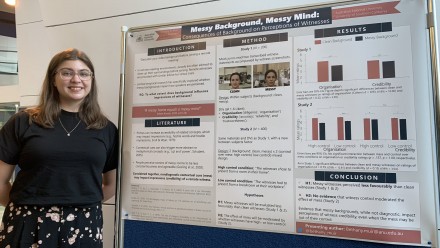Internal neural noise: A contributing mechanism to visual hallucinations
Stephanie Gotsis completed her Masters degree in Neuroscience in 2015, and worked in the Neural Control Systems laboratory at the John Curtain School for Medical Research (JCSMR) investigating the role of astrocytes in the development and maintenance of chronic pain from 2015 to 2016. Currently a second-year PhD student in the Research School of Psychology at the ANU, Stepahnies PhD research aims to investigate underlying neural mechanisms that may be contributing to the development of visual hallucinations in schizophrenia.
Research Background: Visual hallucinations do not only occur in clinical populations like those with schizophrenia, they also present in the general community at a surprisingly high rate (~7%; Waters et al, 2014)). This raises some big questions like: what aspects of normal perception account for visual hallucinations? and could the amplification of these mechanisms/processes result in clinical levels of the phenomenon?
Researchers have proposed that perception may be the product of sensory evidence and expectations in a given context. This relationship is multiplicative in that the more imprecise the sensory evidence is, the more one will rely on expectations to develop their perception. From this view, we suggest that visual hallucinations may arise as a result of an over-reliance on expectations in the face of poor sensory evidence (Geisler & Kersten, 2012). If this is true, what could be the cause of such imprecise sensory evidence in the first place? We propose that neural noise, that is, random or fluctuating neural activity, may reduce the quality of sensory evidence, and in turn, contribute to the development of visual hallucinations.
Proposed methods: In order to identify any causal relationship between neural noise and the development of visual hallucinations, we need valid and reliable ways to measure and manipulate neural noise in healthy human observers. In terms of measuring internal neural noise, over the last 30 years psychophysicists have developed and refined observer models like the perceptual template model (PTM), and applied external noise paradigms (ENP) to characterise and quantitatively estimate intrinsic properties (like internal noise) in an observer (Lu & Dosher, 2008). However, today there are limited techniques that can be confidently used to manipulate the internal noise states of a person. Transcranial electrical stimulation (tES) techniques, which apply a weak electrical current to the brain, have been used in research to modulate cortical activity. A relatively new tES technique, transcranial random noise stimulation (tRNS), has shown promise that it may be used to induce internal neural noise as it can generate a random noise frequency (van der Groen & Wenderoth, 2016).
Current proposed study: This first study will essentially determine if tRNS can be used as an effective manipulation of internal neural noise through the application of active and sham tRNS conditions in conjunction with the PTM and ENP.











